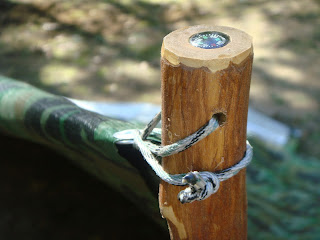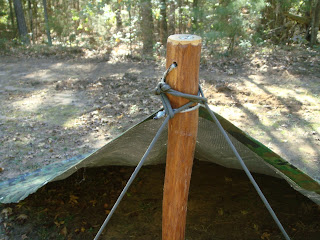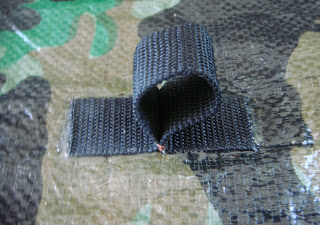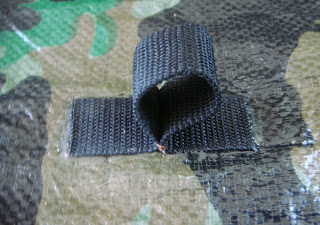The Pole Framework Set-Up
I wouldn’t waste the time or energy to do this
set-up for a one night stay, but if you have a lot of materials available and
if you are going to be in the same location for several nights, you may want to
set up a pole framework for your tarp.
To do this set-up you will need a ridge pole that is
a little longer that the diagonal length of your tarp, and you will need a
couple of forked sticks that are about six feet long. You don’t necessarily have to have forked
sticks as you should have plenty of cordage in your kit that can be used to lash
together some straight sticks into a bi-pod that supports the ridge pole. You will also need a short piece of cordage
to attach the front of the tarp (one of
the cords used to tie around your kit will work for this), and you will need
seven tent stakes.
First set up the framework as pictured below.
Here is how you can lock the forked sticks and ridge
pole together.
Now you drape the tarp over the ridge pole and stake
down the back of the tarp.
Pull the front of the tarp up and tie it off to the
ridge pole and forked sticks then stake down the sides.
The One Stick Set-Up
If you are in a situation where you have very
limited vegetation you can set up your tarp with only one stick. In the example below I have pitched the tarp
using only my walking stick which is about five feet long.
In addition to the single stick you will need two of
the six foot pieces of cordage from your kit and all of your tent stakes.
First you need to stake down the back of the tarp.
Then you need to attach the front of the tarp to
your stick. In this instance I used the
lanyard on my walking stick and looped it through the front grommet on the tarp
and then back over the walking stick. If
you use a found stick you will need to use a short piece of cordage to tie the
tarp off to the stick.
Now pull the tarp forward to tighten up the ridge
line and attach your two, six foot pieces of cordage to the top of the stick.
This next step is easier to do if you have two
people so that one person can keep the stick in place while the other person
sets the tent stakes, but you can do it alone as I did in this instance. So, what you do is drive in a couple of tent
stakes that are about 45 degrees on each side of the stick. The stakes need to be about four feet out
from the stick.
Tie off your guy lines to the stakes to hold the
stick upright. Make sure that the ridge
line of your tarp is tight. Use your
remaining tent stakes to stake out the sides of the tarp and you’re done.


































































